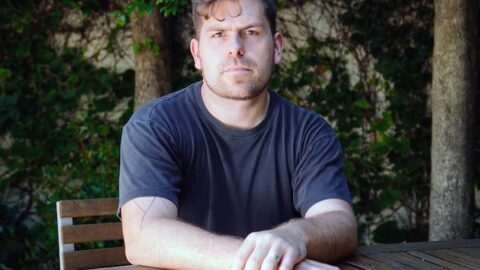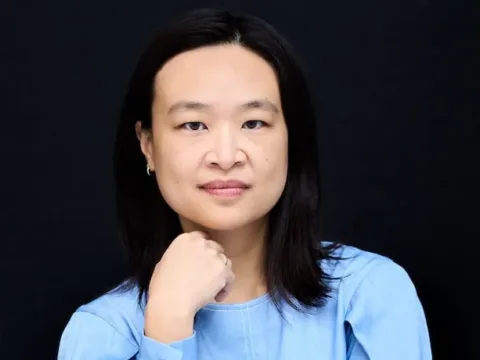Composer, singer, and bandleader Ted Hearne is one sixth of the composer collective Sleeping Giant and half of the vocal-electronics duo R WE WHO R WE. In April 2014, the San Francisco Symphony and the New World Symphony in partnership with publisher Boosey & Hawkes selected him as the third composer of the New Voices program. The San Francisco Symphony performs the West Coast premiere of Hearne’s five-movement work Dispatches on September 30-October 3, 2015 at Davies Symphony Hall.
Congratulations on being selected as the third New Voices composer! How has this position given you the opportunity to bridge the divide between the time-honored symphony orchestra and the contemporary new music community?
Thanks very much! I was really surprised and honored to get the opportunity, and it’s been a great learning experience to work with the three organizations involved (SFS along with the New World Symphony and Boosey and Hawkes).
Your question about “bridging the divide” is a great one and I want to answer in a lot of detail. Hope that’s OK.
First I should tell you what has been entailed in my experience of the New Voices program: I was commissioned to write two pieces (an 8-minute chamber work for 6 violins, and an 18-minute orchestra piece which will see its West Coast premiere at the end of this month), was invited to Miami to prepare the music with the extremely talented and vibrant musicians of the New World Symphony (with very generous allotments of rehearsal time!), and then in the following season brought to San Francisco to have the same works performed by the San Francisco Symphony (That portion begins this month). Boosey and Hawkes contributed greatly toward the copying costs of the music, and I also met with members of the staff there who talked with me at great length about aspects of the publishing industry, and the inside perspective was really helpful at this point of my career.
So, while this doesn’t have much to do with how I personally bridged any divides, it should be said that the New Voices program itself provides opportunities for collaboration, education, and performance that wayyyy more composers, from diverse backgrounds and aesthetic predilections, should have (but don’t usually).
I didn’t get a ton of lead time to conceive of and actually write the piece, but the schedule and setup of the New World Symphony residency gave maximum opportunity for listening and revisions, and I especially appreciated how it encouraged the building of relationships with the individual musicians in NWS. As you probably know, this excellent orchestra is comprised of players from the top tier of orchestral musicians, and most if not all of them are in their 20’s. When I first arrived, a lot of them seemed somewhat skeptical of (but not jaded or angry or completely closed to) many of the less conventional aspects of the piece I’d written, but because of the generous amount of rehearsal time and the immersive aspect of life at NWS, that skepticism dissolved into understanding and commitment and we were able to workshop the music effectively and craft (along with the fabulous conductor Christian Reif) some of the most rewarding performances I’ve ever had.
Now if we’re gonna talk about bridging the divide, it should be mentioned how far the experience of a composer working with an orchestra can fall from the experience I had with New World. Usually there’s way less rehearsal time, yes, but there are financial reasons for that. More troubling to me is the paucity of excitement and curiosity that we composers sometimes encounter among orchestral musicians when it comes to the challenging but potentially rewarding project of creating a ‘new’ work together.
There are lots of notable exceptions of course, and I don’t mean to impugn all orchestra musicians here, because I’ve encountered many who are quite open-minded and ready to bring an experimental spirit. The LA Phil is a great example, with extremely robust programming that supports all sorts of compositional voices and an orchestra trained to withhold judgment of a piece at least until after they’ve performed it. But… I’m also used to walking into orchestra rehearsals with musicians trashing my music before they’ve even played a note, and I’ve looked out to orchestras as I’m introducing myself only to encounter a roomful of 80-90% dead eyes. Then, when an ensemble full of musicians who expect nothing good sight-read a new piece, inevitably somewhat inaccurately, that piece usually sounds pretty bad upon its first hearing, which only solidifies musicians’ (and composers’) discouragement even more.
When you combine this so-often-hostile attitude from orchestral musicians with the downright indifference shown to new work by so many orchestral audiences (usually skewing way older and way whiter than the population of whatever city the orchestra is based in), I think lots of composers are discouraged from writing for orchestras altogether.
It’s not like in a perfect world every composer should want to write for an orchestra — I’m not saying that — but the current situation most values the work of composers whose music requires a minimum amount of critical thinking or sonic experimentation on the part of the musicians. And I don’t think that’s at all healthy for the medium (or any type of music), especially with so many incredible young composers working in this country today, in what I know to be a truly rich and exciting contemporary music community (which you allude to).
I’ve never played in a (non-kazoo) orchestra, so I can only give uneducated guesses to why this divide exists, but it’s a pretty big divide. What the New Voices program, and the SF and NW Symphonies are attempting to do, is give ample support and time for communication between composers and orchestras. There may be other actions that need to be taken in order to help broaden the scope of new music in the orchestral world, but this type of thing is an essential first step, and I hope more organizations decide to undertake similar measures, with a broad array of composers from different styles and traditions.

Dispatches draws from widely-varied source material that is generally heard outside of the concert hall. Did you strive to create an overall sense of coherence across the five movements, or was coherence not the end goal?
Imagine five pieces of music you might hear, in their entirety or in snippets, as you go about your day today. These musics may not have been conceived together as a single work or have originated from a singular voice, yet there are inevitably commonalities among them, one of which is that (due to some choice you made, however fleeting or seemingly unimportant) they have become a part your day and thus make up one small part of the blueprint of you. That’s the kind of coherence I’m looking to tap into with the five movements of Dispatches.
While we are considering both varied source material and coherence, eighth blackbird recently premiered Sleeping Giant’s evening-length work Hand Eye, which draws inspiration from visual art. How do these cross-disciplinary connections influence the experiences of performers and audience members?
8bb is an astounding group and I feel so lucky to be able to work with them. They gave a sort of “soft premiere” of Hand Eye, which is a big collection of pieces by the six of us composers, a few months ago at the Great Lakes Chamber Music Festival and will be workshopping it until a Carnegie Hall premiere this coming January, which we’re all super excited about.
In Hand Eye, the six of us chose one work of art from the (unfortunately private) contemporary art collection of Stuart and Maxine Frankel to use as inspiration for the music we wrote. Although the verdict is still out, I’d say the connection to the visual art mostly serves the same function as an interesting program note — an outside, nonmusical perspective, to hold over or juxtapose against the music itself in order to guide audience thinking in a certain way. Like all program notes, you gotta take the good with the bad…
Considering your recent theatrical works The Source (2014) and Katrina Ballads (2007) in addition to your collaborations with Erykah Badu (2013), how does the removal of both text and the human voice in Dispatches effect your compositional process?
I’m a singer, and my first pieces were works for voices, so that’s always felt like my home turf as a composer. Taking text and singers out of the equation often helps me push my sonic boundaries and step outside my comfort zone, which also opens up more opportunities for failure. Because of that, many of my instrumental music came from a more painstaking, trial-and-error, experimental process, and Dispatches is no exception!
In your experience with the New World Symphony and the San Francisco Symphony thus far, how can composers, performers, conductors, ensembles, and audiences alike assist newly-composed orchestral works in entering the permanent repertoire?
When an orchestral piece has second, third, and fourth performances, it is able to come into itself much more. The San Francisco Symphony is about to give Dispatches its second run, and the piece will absolutely be improved this time around, both because I was given the opportunity for revisions and the SFS players/conductor will have had the opportunity to learn from the NWS players’ rehearsal process. Commissioning consortiums allow for pieces to receive multiple performances, and I think this is a great model, essentially writing second, third, and fourth performances into the commissioning agreement. Also, just to reiterate, the New Voices model is a good one and hopefully other orchestras will find a way to follow suit and create their own versions.
Personally, I have a lot of unanswered questions about why I write orchestral music to begin with. I love the energy you can create with 50+ musicians in a room together, and I love the focused communal experience of receiving a piece of live music together. And I honestly love the amazing system of notation that allows for this huge group of individuals to be harnessed and controlled like a giant sound monster. But it really discourages me when musicians’ and audiences’ stylistic palette don’t match the kind of versatility and pluralism that I’ve come to expect from other types of ensembles — like, do I want to write music that is primarily heard and played by people who don’t know (or care to know) who Kendrick Lamar is?
So for me, I think the question for new orchestral work is more about what the repertoire actually is, and how we can –if we should — help it come to include a broader and more varied collection of voices.
























